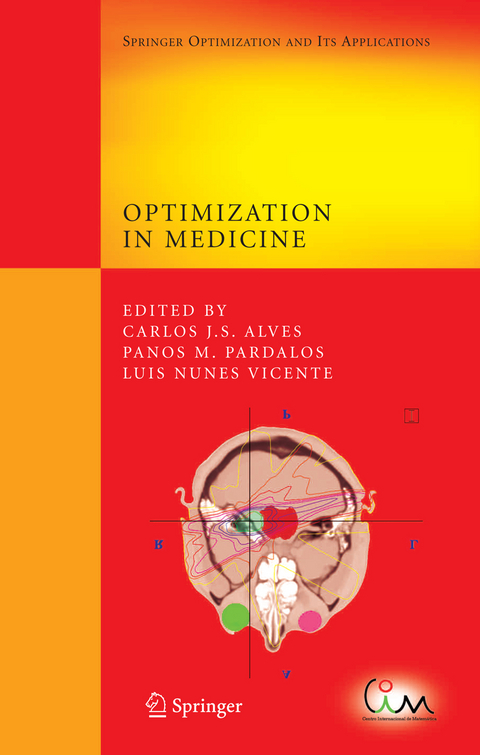
Optimization in Medicine
Seiten
2010
|
Softcover reprint of hardcover 1st ed. 2008
Springer-Verlag New York Inc.
978-1-4419-2517-6 (ISBN)
Springer-Verlag New York Inc.
978-1-4419-2517-6 (ISBN)
Optimization techniques have also been used to automate the planning process in Gamma Knife treatment, as well as to address a variety of medical image registration problems.This work grew out of a workshop on optimization which was held during the 2005 CIM Thematic Term on Optimization in Coimbra, Portugal.
Optimization has become an essential tool in addressing the limitation of resources and need for better decision-making in the medical field. Both continuous and discrete mathematical techniques are playing an increasingly important role in understanding several fundamental problems in medicine.
This volume presents a wide range of medical applications that can utilize mathematical computing. Examples include using an algorithm for considering the seed reconstruction problem in brachytherapy and using optimization-classification models to assist in the early prediction, diagnosis and detection of diseases. Discrete optimization techniques and measures derived from the theory of nonlinear dynamics, with analysis of multi-electrode electroencephalographic (EEG) data, assist in predicting impending epileptic seizures. Mathematics in medicine can also be found in recent cancer research. Sophisticated mathematical models and optimization algorithms have been used to generate treatment plans for radionuclide implant and external beam radiation therapy. Optimization techniques have also been used to automate the planning process in Gamma Knife treatment, as well as to address a variety of medical image registration problems.
This work grew out of a workshop on optimization which was held during the 2005 CIM Thematic Term on Optimization in Coimbra, Portugal. It provides an overview of the state-of-the-art in optimization in medicine and will serve as an excellent reference for researchers in the medical computing community and for those working in applied mathematics and optimization.
Optimization has become an essential tool in addressing the limitation of resources and need for better decision-making in the medical field. Both continuous and discrete mathematical techniques are playing an increasingly important role in understanding several fundamental problems in medicine.
This volume presents a wide range of medical applications that can utilize mathematical computing. Examples include using an algorithm for considering the seed reconstruction problem in brachytherapy and using optimization-classification models to assist in the early prediction, diagnosis and detection of diseases. Discrete optimization techniques and measures derived from the theory of nonlinear dynamics, with analysis of multi-electrode electroencephalographic (EEG) data, assist in predicting impending epileptic seizures. Mathematics in medicine can also be found in recent cancer research. Sophisticated mathematical models and optimization algorithms have been used to generate treatment plans for radionuclide implant and external beam radiation therapy. Optimization techniques have also been used to automate the planning process in Gamma Knife treatment, as well as to address a variety of medical image registration problems.
This work grew out of a workshop on optimization which was held during the 2005 CIM Thematic Term on Optimization in Coimbra, Portugal. It provides an overview of the state-of-the-art in optimization in medicine and will serve as an excellent reference for researchers in the medical computing community and for those working in applied mathematics and optimization.
The influence of dose grid resolution on beam selection strategies in radiotherapy treatment design.- Decomposition of matrices and static multileaf collimators: a survey.- Neuro-dynamic programming for fractionated radiotherapy planning.- Randomized algorithms for mixed matching and covering in hypergraphs in 3D seed reconstruction in brachytherapy.- Global optimization and spatial synchronization changes prior to epileptic seizures.- Optimization-based predictive models in medicine and biology.- Optimal reconstruction kernels in medical imaging.- Optimal control in high intensity focused ultrasound surgery.
| Erscheint lt. Verlag | 24.11.2010 |
|---|---|
| Reihe/Serie | Springer Optimization and Its Applications ; 12 |
| Zusatzinfo | 60 Illustrations, black and white; X, 195 p. 60 illus. |
| Verlagsort | New York, NY |
| Sprache | englisch |
| Maße | 155 x 235 mm |
| Themenwelt | Mathematik / Informatik ► Mathematik ► Analysis |
| Mathematik / Informatik ► Mathematik ► Angewandte Mathematik | |
| Mathematik / Informatik ► Mathematik ► Finanz- / Wirtschaftsmathematik | |
| Medizin / Pharmazie ► Allgemeines / Lexika | |
| Medizinische Fachgebiete ► Radiologie / Bildgebende Verfahren ► Radiologie | |
| ISBN-10 | 1-4419-2517-1 / 1441925171 |
| ISBN-13 | 978-1-4419-2517-6 / 9781441925176 |
| Zustand | Neuware |
| Haben Sie eine Frage zum Produkt? |
Mehr entdecken
aus dem Bereich
aus dem Bereich
Buch (2023)
Thieme (Verlag)
190,00 €


